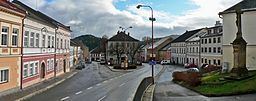- summer (DST) CEST (UTC+2) Area 29.93 km² | Elevation 443 m Local time Monday 1:02 AM | |
 | ||
Weather 11°C, Wind N at 16 km/h, 77% Humidity | ||
Štíty ( [ˈʃciːtɪ]; until 1949 Šilperk German: Schildberg) is a small town in the Olomouc Region of Moravia, in the Czech Republic. It has about 2,000 inhabitants. The town is known for its freestyle skiing centre whose operator is the Winter Olympic gold medalist Aleš Valenta.
Contents
Map of %C5%A0t%C3%ADty, Czechia
Etymology
The original name was Schildberg in German language and Šilperk in Czech language. The population was ethnically mixed until 1945 when Sudeten Germans were expelled. After World War II, the town was renamed as Žalkov; however, this name was not popular, thus new name Štíty was created.
Meaning of original name as well as new one is connected with a shield. Grammatically, Štíty is in form of plural, meaning "shields".
Geography
Štíty is located in west part of Šumperk District in Olomouc Region of Czech republic. Historical centre is situated on the promontory above Březná river which is part of Orlické Hory mountain range. Štíty town council also administers villages of Březná, Crhov and Heroltice. Surrounding area is hilly. Agricultural land is not fertile therefore number of inhabitants has never reached higher numbers.
Feudal history
The oldest document about the town was discovered in Liechtenstein archive. It is dated 4 April 1365 referring to the estate transfer from Zdeněk ze Štenberka to a man named Heylin. The document also states that the transferred estate is connected to the right coming from year 1278, thus town existence before the 13th century is probable,
Another document comes from 1307 and 1308 which is a complaint of monks from Lanškroun who had to pay tribute of 180 silver hryvniatos to the robber baron Ježek ze Šilperka (literally Jezek from Šilperk, respectively from Štíty).
According to Zemské desky, Štíty was owned by the House of Štenberk from 1308 who often leased the town to another aristocratic families. Štíty coat of arms is inspired by Štenberk coat of arms.
In 1480, the town was sold to Jan Dalčický z Dačic, who donated Štíty as a dowry to Aleš Krčma z Koněpas. During late 15th and early 16th century the town often changed its owners.
From 1553, the owner was Matyáš Žalkovský, who sold the town to Pavel Catharin z Catharu, whose sons sold Štíty to Jan Odkolek z Újezdce in 1602.
Štíty was heavily damaged by fire in 1557.
Jan Odkolek mladší participated in the uprising against Habsburg rule from 1618 to 1620, and after suppression of the revolt his property, including Štíty, was confiscated. Odkoled escaped to Poland and was convicted in absentia to death.
New owner was The house of Liechtenstein, who administered the town to the fall of feudal system in 1848. Lichtenštein rule was not popular because originally utraqist town was under strong pressure of recatholization, also corvée obligation was very hard. Liechtenstein's cruel administration was mitigated by intervention of Charles VI, Holy Roman Emperor.
In 1642 and 1643, the town was looted by Swedish soldiers under the command of general Lennart Torstensson. In 1646, Štíty was looted by Swedish soldiers again, under the command of general Arvid Wittenberg this time. Historical report from Horní Studénky administrator says that "all houses were burnt down expect the church and the town hall" Periodical looting caused famine which happened in 1649.
Štíty was stricken by plague in 1680 and again in 1713. As a reaction the plague column was erected in 1713, which still can be found in the town's main square.
During war of the Austrian Succession, Prussian hussars fought minor victorious battle with Austrian soldiers in town's neighborhood. As a result, Prussians invaded to Štíty and started looting. Allegedly, one of the Štíty residents, the man named Dušek, shot from church tower to the group of hussars. Prussian major Schütz ordered to execute 83 Štíty men and to burn the town down.
Another devastating fire stroke Štíty on 21 March 1799. According to the chronicle of Welzl, 74 houses were destroyed. The fire started in local forge.
Štíty castle
The castle was situated in the place of the current Church of Nenebevzetí panny Marie. The structure was not strategically significant and was probably burnt down by hussite army in 1424. Ruins were used as a building material for new houses.
WWII
Munich agreement let the annexation of Czechoslovak borderland including Štíty by Nazi Germany. Most of Czech citizens were evacuated to the inland. Kubíčkům mlýn, the mill in the area Na Pilníku, was the meeting point for local resistance movement from 1941 to 30 March 1944, when resistance members were imprisoned. Labor camps for Polish and French prisoners were operating near the town.
Štíty was liberated by Red Army at midnight from 4 to 5 May 1945.
Later history
National Language Centre here for teaching Czech language to the international students (mostly from Vietnam and Africa) was operating in the town from 1990 to 2001.
